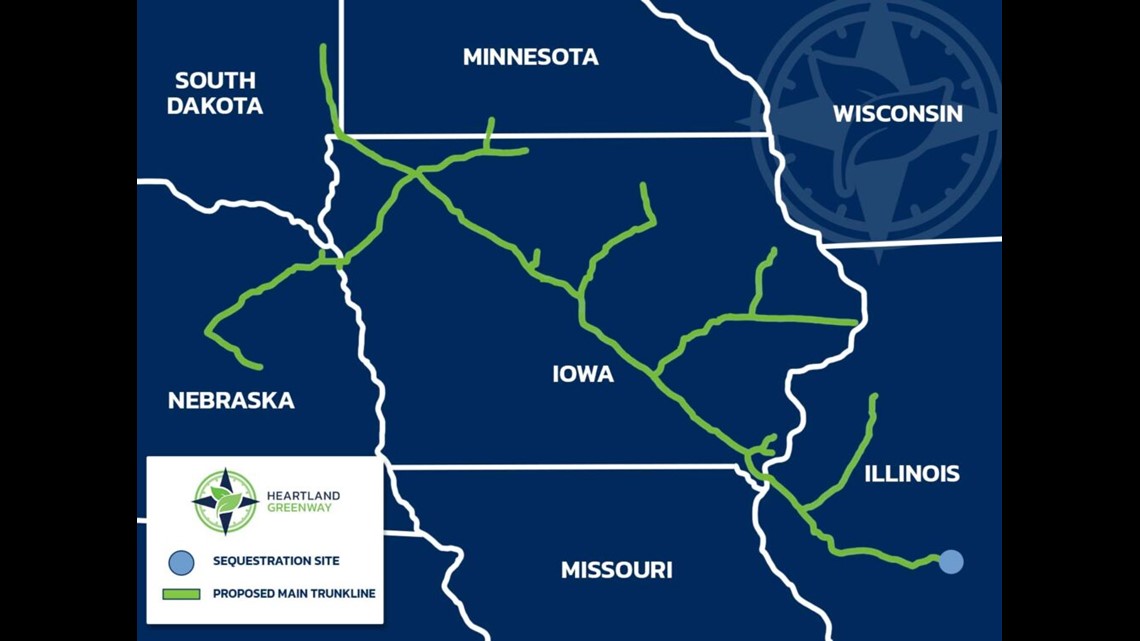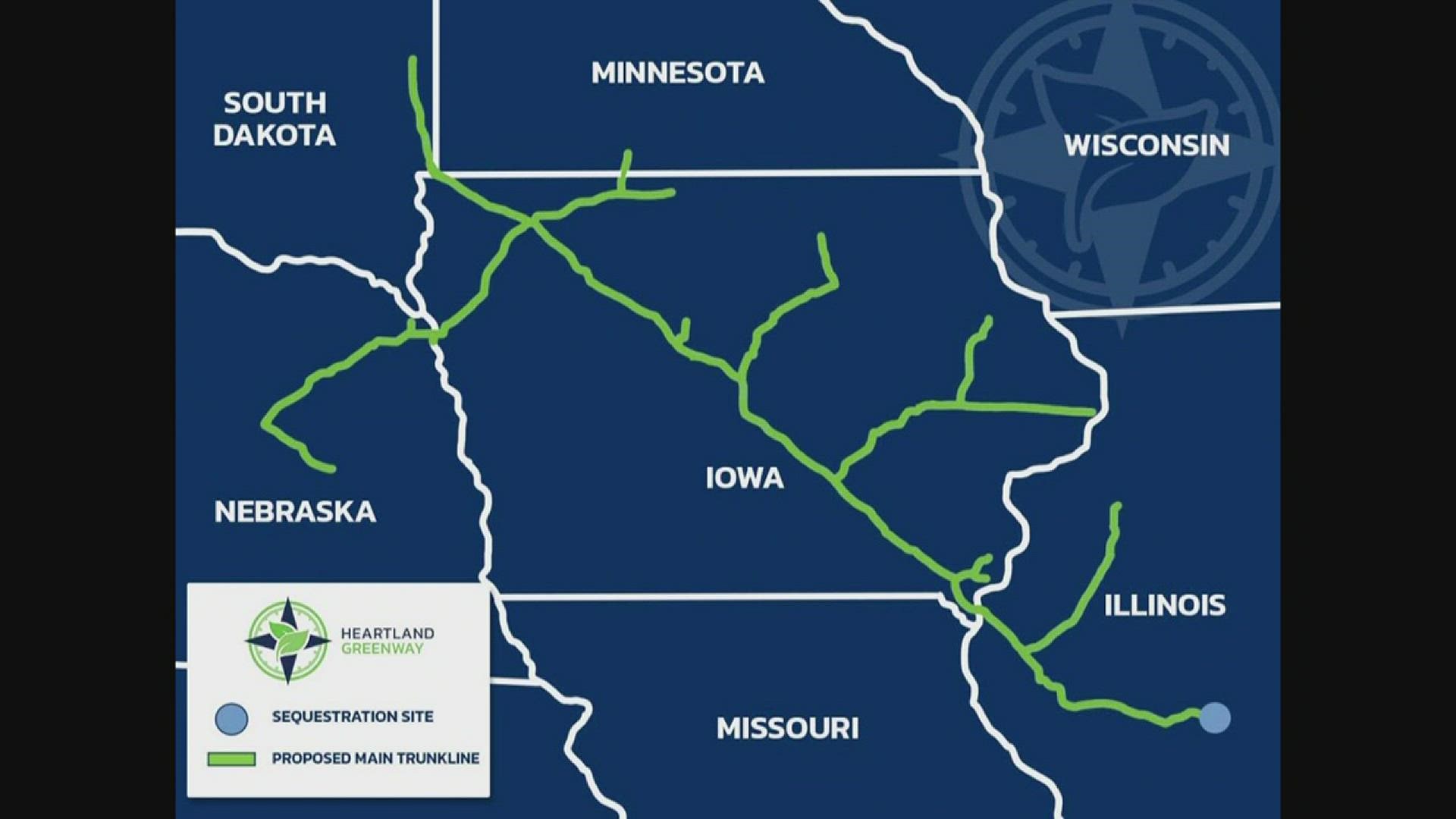CLINTON, Iowa — An infrastructure company has proposed building a 1,300-mile carbon capture pipeline through five states, including Iowa, Illinois, Minnesota, Nebraska and South Dakota. About 900 miles of the pipeline would run through 36 Iowa counties.
Navigator CO₂ Ventures is calling the pipeline system "Heartland Greenway."
The pipeline would capture carbon dioxide from the air, turn it into liquid and then store it in the ground at least a mile deep at a sequestration site in Christian County, Illinois.
"It stays in that liquid phase, ultimately, where it's injected into the ground, and over the course of thousands of years, (it) mineralizes and becomes part of the rock and the sandstorm formation there in South Central Illinois," said Elizabeth Burns-Thompson, the vice president of government and public affairs for Navigator.
Representatives from Navigator and the Iowa Utilities Board will host 37 meetings now through mid-January to share information with landowners and answer any of their concerns. On Tuesday, Dec. 7, they met with several hundred Clinton County residents.
Landowners received letters from the company inviting them to the information session.
"We've indicated about a half-mile-wide corridor, based on what we've looked at proactively in terms of pulling all of those publicly available datasets, avoiding population centers, avoiding sensitive lands and protected lands, as well as following existing easements as much as possible," Burns-Thompson said. "Then within that corridor is when we can move into that next step of determining, collectively with landowners, what does that ultimate route look like?"


"It sounds like you, as a private company have found customers that you want to provide a service to," resident Mike Ossian said during the public Q&A portion. "And to provide a service, you need to run pipelines through my property and other properties here. And I don't understand how that benefits myself or my neighbors, or the public in general."
The carbon capture pipeline would collect CO₂ from 20 receipt points at ethanol plants and fertilizer processors. The facilities would pay Navigator to store the carbon dioxide. This would help them lower their carbon footprint and allow them to sell ethanol in states, like California, who require smaller carbon footprints, according to Burns-Thompson.
"Carbon capture and storage has the potential to reduce the carbon intensity of those in products, this ethanol or fertilizer, by up to 50%, which is substantial progress," Burns-Thompson said.
More than 40 billion tons of carbon dioxide is emitted into the air each year, according to Navigator. Heartland Greenway would be able to transport and sequester up to 10 million metric tons in its first year and expand to up to 15 million per year. That's the capacity to capture and store the equivalent of emissions from 3.2 million cars, carbon dioxide sequestered by 18.3 million acres of U.S. forest and eliminate the entire carbon footprint of the Des Moines metro area three times over.
Participating facilities will be eligible for a federal tax credit up to $50 per metric ton of sequestered carbon. Facilities that reduce emissions could also have the potential to achieve a premium in Low-Carbon Fuel Standard markets, leading to 20-40 cents increased value per gallon and annual revenue gains between $20-40 million per plant.
Ardith Barr also received a letter from Navigator. She's owned almost 300 acres of farmland in between Dewitt and Low Moor.
"I've never had any of this go through my property before," Barr said. "One of my concerns is if it's toxic that they're taking out of the air and pumping it through the ground, then if it leaks, what if it's close to where you live? What will it do to us?"
Navigator said it's required by law to not put the pipeline closer than 25 feet to someone's home. It would run at least five feet deep, and below any other existing infrastructure, such as a natural gas line, in order to alleviate any potential line strikes.
At the sequestration site in South Central Illinois, the injection well stores it more than a mile below the water resources, according to Burns-Thompson. The wells will utilize a Mt. Simon formation.
"The unique nature of that formation is such that is has hundreds of feet of caprock, and that caprock effectively serves as a seal to make sure that that CO₂ isn't coming back out of where you put it," Burns-Thompson said. "Not only is there the injection wells itself, there's a number of other wells that associated with that that are specifically for monitoring purposes to make sure that once the CO₂ is underground, that it's not moving away from where we've put it."
There is another meeting for Des Moines County noon Dec. 8 at LOFT Events, located at 416 Jefferson St. in Burlington.
The Iowa Utilities Board will host a virtual meeting 5:30 p.m. Jan. 19. Details and virtual registration information will be posted on the IUB's online hearing meeting calendar.
In Illinois, there is a meeting for Knox/Henry County residents 10 a.m. Jan. 11 at at the Knoxville American Legion, located at 749 Henderson Rd. in Knoxville.
Navigator expects to ask for permits after the completion of all its public meetings in early 2022. The company hopes to begin construction in 2024 and to have the pipeline online in 2025.
It will work with agencies in the five states, such as the Iowa Utilities Board, local entities and federal environmental agencies throughout the permitting process.
There are more than 30 carbon capture sequestration facilities planned for the U.S. and around the world, according to Navigator. Existing and proposed projects can reduce global CO₂ emissions by almost one-fifth and lower the cost of addressing climate change by 70%.

